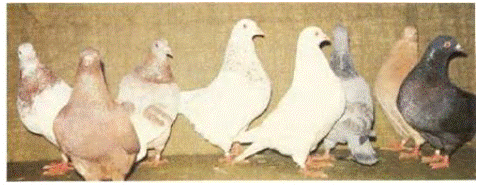|
Changes in color varieties and genotype changes in pigeons
When the first black pigeons appeared in our flock, they were duff
black in color. Only the crossbreeding of intensely colored pigeons
from other breeds brought depth and luster to the color. As the
author later learned from the literature, he had thereby added the
genetic factor "deep" and possibly other intensifying factors to the
existing genotype. No one mourned the loss of the dull black. This
was different with the yellow color variety. In many breeds, the
golden color variety replaced the yellow without this being recorded
in the standard. If standards consistently require intense
coloration for all color varieties, then with recessive reds, the
goldens with less dilution of the pigment automatically have an
advantage with the judges. It is only a matter of time before
goldens displace the yellows in the breed and yellow enthusiasts
abandon breeding.
Analogous effects may happen in other colors. An exchange of genes
appears to be occurring unnoticed, unchallenged at shows, even in
some strains of Texans with the distinctive sex-dimorphism due to
the factor Faded.

 
1,0 Texan faded dark (S. Ringleb, 11543), 0,1 Texan faded blue bar
(W. Hohenberger, 11554, and W. Hamel, 11555). Source: Exhibition
Hanover 2009
The author had already pointed out in the show report for the 2009
Hanover Young Poultry Show that among the blue hens there were some
that were indistinguishable from blue King hens without the Faded
factor. A clear blue with black bars. Not washed out or slightly
cloudy, as described in the standard. Some judges seemed quite
impressed. It cannot be ruled out that a similar development as with
yellow and gold could be triggered.

Blue Texan female at the Expo Canoniale Fribourgeoise 2023. Source:
http://www.taubedaisy.de/rasse-m-z/texaner.htm.

Faded and Chalky. Source: Bruders et al. 2020
At the time, the author had thought of crosses with King hens and of
hens from these crosses without the Faded factor. Probably wrong,
because in recent years, various similar pictures of blue-barred
Texans have been shown. Probably no longer Faded. Possibly Chalky, a
rare Stipper allele. Heterozygous cocks show hardly any change in
their blue coloration. It is generally assumed that hemizygous
females and heterozygous cocks have the same coloration when it
comes to the alleles of the stipper genes. This also applies to
Chalky. A heterozygous Chalky cock is pictured next to a faded hen
in the 2020 molecular genetic study (Bruders et al. 2020),
demonstrating the difference.
The gene doesn't necessarily have to have entered the Texans through
crossbreeding. The study had shown that the genes, considered to be
alleles, also differ in that larger chromosome segments were
sometimes present multiple times (copy number variation). Changes at
other gene loci that control aspects of pigment production or
deposition, in conjunction with an increase or decrease in the
number of copies, could lead to phenotypes classified as stippler
alleles (p. 14). It doesn't necessarily have to be chalky, either,
as the authors cite reports from breeding that suggest other
phenotypes arose spontaneously from existing variants.
Given today's variations, it is interesting to search for documents
on the original colorations. Texans were recognized in the USA in
1962, and Levi's 1965 illustrated book only depicts a dominant red
female. An early picture of a group with different colorings was
published in the 'World Pigeon Magazine' in 1978, including a hen
that matches the description in the German standard: “The color is
not intense and washed out, including the checkering and banding.
Slightly cloudy shield color is permitted."

Groupe of Texans in different Colors. Source: World Pigeon Magazine
1978
Literature:
Bruders, R., H. Van Hollebeke et al. (2020), A copy number variant
is associated with a spectrum of pigmentation patterns in the rock
pigeon (Columba livia). PLoS Genet 16(5): e1008274
Levi, W.M., Encyclopedia of Pigeon Breeds, Ney Jersey 1965
Sell Axel und Jana, Vererbung bei Tauben, Reutlingen 2004, 2007
https://www.taubensell.de/004_Neu_Ausstellungen/junggefluegel_hannover2009.htm
|